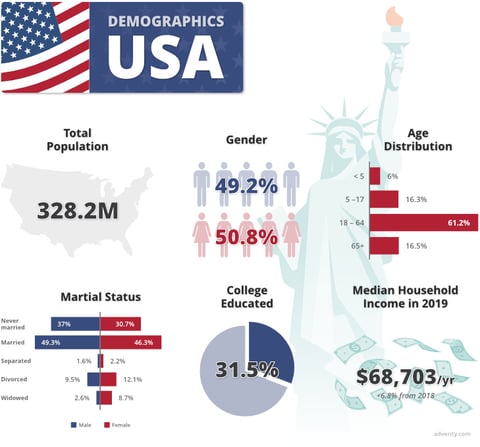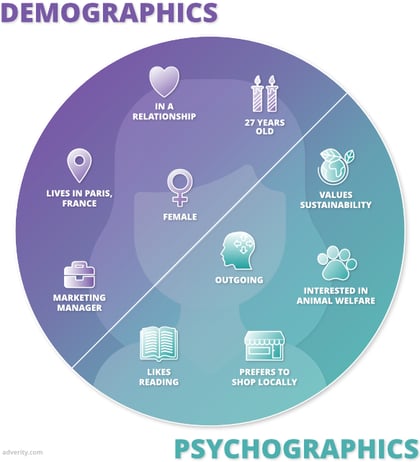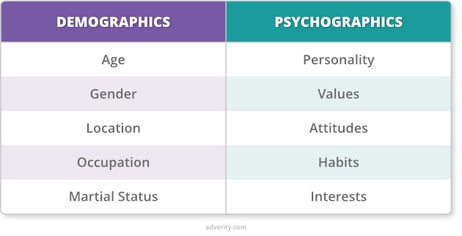More and more businesses are recognizing that a data-driven approach leads to greater marketing success. The problem is, there’s a bewildering array of data available to marketers, particularly in SaaS firms, whose stores, products and marketing channels are digital — and therefore data-centric – in nature.
However, data can be your strength if you can collect and analyze it in order to understand your customers better and target them more effectively. Here are five key categories of data that can help you build more accurate customer profiles that will transform your SaaS marketing, advertising and sales activities.
Understanding Demographics
It’s no understatement to say that customer demographic data is a goldmine for marketers. It’s a treasure trove that will enable you to create powerful customer segmentation.
Data-driven segmentation is an increasingly popular marketing strategy. It uses data to identify the interests of specific groups by applying analytics techniques. You can then speak intentionally to these through targeted messaging, ads and offers.
Highly useful customer demographics data includes sex, age, income, occupation, ethnicity, relationship status, children, car, and geographic location. You can use this valuable data to sharpen your marketing campaigns across social media, email, ad and online platforms.

Image shows sample demographics of population in USA.
Psychographic Insights
Alongside demographics, psychographics data is also highly valuable for marketers. It will tell you things like: the personality type, lifestyle, values, concerns and spending habits of your customers. But, whereas demographics might tell you the household income, psychographics can tell you how the person spends it.
Psychographics can also tell you the social media platforms the individual favors, and the online groups and forums they belong to. This information can help you develop a more rounded picture of the customer. You can then target segments — or micro-segments — with timely, personalized and relevant content and offers.


Differences between demographics and psychographic insights.
Website Intelligence
For SaaS businesses, the majority of website traffic comes through organic search, referrals, email, social media, paid search and display ads. You want to keep site visitors engaged, so it’s important for marketers to track and analyze website activity so they can raise their game. This means measuring things visitor numbers, clicks, bounce rates, signups and downloads.
It’s also worth knowing how long customers stay on your site, on particular pages, and as much of their real-time behavior as you can glean.
You can then apply marketing analytics to all this data to increase conversions and improve the online customer experience.
Know Your Customers
Service providers are in a good position to build up useful intelligence about their user history. This may come from contact center calls, online web chat interactions, platform logs, user forums, or email correspondence with your account managers or customer service representatives.
You can use this information to understand customer buying patterns, for example: how often customers move from free trial signup or freemium scheme to the full suite. Or how many switch on premium features. It also helps you discover trends in price sensitivity, customer loyalty and churn.
Product or Service Adoption
Non-usage of applications can be a sign of customer churn. But it can be harder to know why the business retains its customers. The answer could lie in how often the product or service is being used.
SaaS customer-facing teams haven’t always had ready access to this information. It’s traditionally been the remit of engineering teams. However, marketers who have access to usage data can increase loyalty and lower churn by combining it with customer experience indicators, such as support interactions or survey feedback.
This can help to explain how customers are using your products or services: which types of customers only use the standard features, and which ones are ready to buy more advanced ones, for example.
Marketing Dashboards
It’s not practical or sufficient to record all of this information in an isolated manner. The real value comes when you put all the data on a marketing visualization dashboard — underpinned by data automation and transformation — and have the tools to analyze it effectively.
Adverity’s powerful marketing analytics technology stack makes it possible for SaaS marketing practitioners to create visual dashboards that display detailed and actionable marketing and business information. This enables SaaS marketing teams to drive the customer experience, innovate and instigate change.
So, by measuring, understanding and intelligently analyzing customer demographics, psychographics, web activity, service interactions and SaaS usage, marketers can gain the edge on the competition. They can reduce customer churn, delight existing customers, and create campaigns that successfully engage and win new business.
Want to take your data-driven marketing to the next level with a powerful dashboard?
Download our free eBook and learn what your marketing dashboard could look like.










